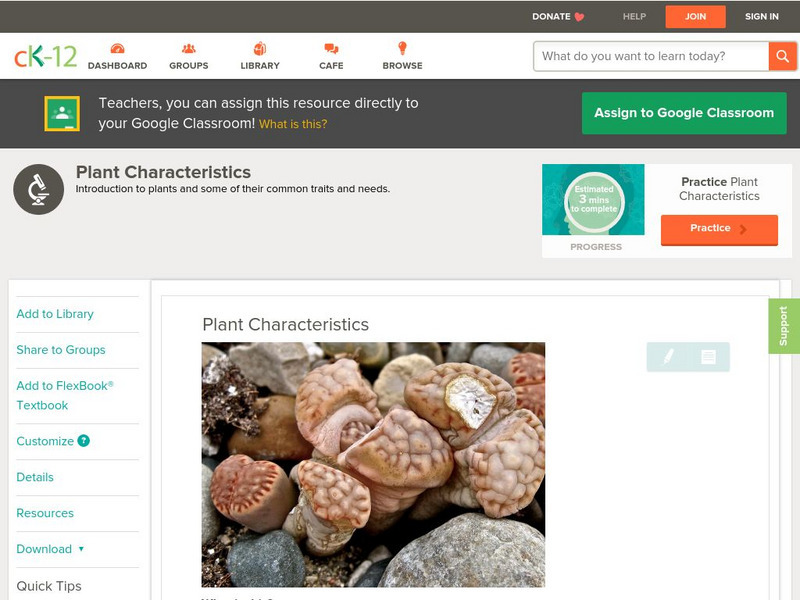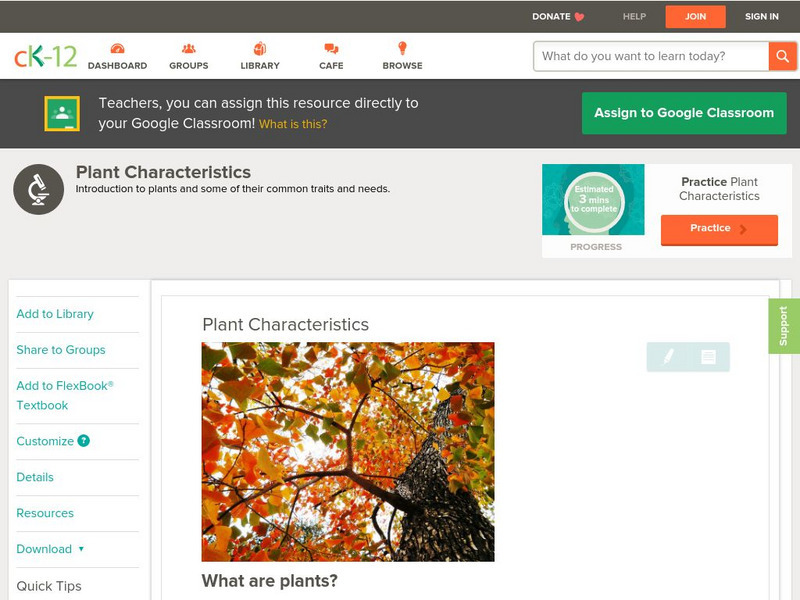Hi, what do you want to do?
Curated OER
The Portable Niche
Third graders, in groups, research animals, plants, and conditions found in ecosystems.
Curated OER
Linnaeus' Latin Lingo
Students use Latin and Greek words to figure out species names for whales.
Curated OER
Iowa Agriculturist
Tenth graders review the Iowa Agriculturist, retell the annual and seasonal cycle of farming and describe pioneer farming practices.
Curated OER
Population Dynamics
Students watch a video on population dynamics. They conduct an experiment where they fill up a designated space with students. They recreate multiplying rabbits using beans.
Curated OER
Lewis and Clark in Washington Shrub Steppe Habitat
Students reserach the flora and fauna next to their school for two days and also Lewis and Clark's journals. They compare Lewis and Clark's description of the area to the one they have today. They also discuss the idea of restoring...
Curated OER
Spectrophotometry Lab
Students use a machine called a spectrophotometer to determine how much light is absorbed by certain substances. Students record the absorbance and the % of light transmitted for different color solutions, graph their results, and then...
Curated OER
Pulse
Students determine a baseline pulse rate then chart the changes in rate with exercise. They describe the changes and develop a rationale for their observations. The task assesses students' abilities to make simple observations, determine...
Curated OER
Animals Piece by Piece
Young scholars sort organisms and objects into groups according to their parts and describe how the groups are formed.They identify body parts of animals from puzzle pieces, assemble the puzzle, and name the animal.
Curated OER
Tree Study
Students measure the lengths of provided leafs to the nearest millimeter. Students identify trends in the data as well as sourced of inaccuracy and formulate additional questions that could be investigated to enhance their understanding.
Curated OER
Mythical Animals
Students create imaginary animals by assembling pictures of body parts from pictures of real animals. This is one of three linked tasks. The others are "Who's Parts Do I Have?" and "Animals Piece by Piece."
Curated OER
Insects and Spiders
Students make either and insect or a spider using materials their teacher provides. They then draw of picture of their organism and defend why it is either a spider or an insect.
Curated OER
Geo-Exchange Box
Students send a box of clues to a class in another Oregon community along with hints to help them study about their community. Students research their own geographic area, determine what they send in their box, then collect and assemble...
Curated OER
Soil Organisms
Young scholars work together to collect soil samples from different locations. In the samples, they identify the macroorganisms and classify them. They identify the conditions that affect how macroorganisms grow. They also analyze and...
Curated OER
Biomes- Culminating Slideshow
Third graders investigate the concept of differentiation of biomes. They select one biome and conduct research to obtain information. In particular, 3rd graders demonstrate how to find a biome on a map. The information is used to create...
Curated OER
Making a Food Web and Learning About Ecosystems
Third graders examine the difference between a food web and food chain. They also examine the importance of the sun in a food web and food chain. Students understand what happens when you remove parts of the chain.
Curated OER
Choosing the Correct Questions
Students ask themselves questions while reading to comprehend the material and improve their memory. They should ask why, when, where and how questions when they are reading an article. Students explore the different strategies on what...
Curated OER
Six Levels of Ecological Organization
Ninth graders describe the six levels of ecological organizations and give examples of each. They also differentiate between food chains and webs and identify trophic and consumer levels in food chain and food webs.
Curated OER
Estuarine Habitats
Sixth graders study the important habitats, flora, fauna, and physical factors of coastal habitats. They compare the aquatic habitats to terrestrial habitats by researching and completing tables with the information.
CK-12 Foundation
Ck 12: Episd: Plant Characteristics
[Free Registration/Login may be required to access all resource tools.] An introduction to the kingdom Plantae is presented. Students will identify common plants by their characteristics.
CK-12 Foundation
Ck 12: Life Science: 7.1 Plant Characteristics
A textbook tutorial over biological characteristics of plants.
CK-12 Foundation
Ck 12: Life Science: Plant Characteristics
[Free Registration/Login may be required to access all resource tools.] What do you think distinguishes plants from other organisms? Learn more about plant characteristics in this learning module produced by CK-12.
CK-12 Foundation
Ck 12: Biology: Plant Kingdom Study Guide
Explore the diversity and taxonomy of the plant kingdom.
CK-12 Foundation
Ck 12: Biology: Plant Characteristics
[Free Registration/Login may be required to access all resource tools.] Introduction to plants and some of their common traits and needs.
CK-12 Foundation
Ck 12: Biology: Plant Characteristics
[Free Registration/Login may be required to access all resource tools.] Introduction to plants and some of their common traits and needs.
Other popular searches
- Edible Plant Characteristics
- Animal Plant Characteristics
- 3 Plant Characteristics
- Land Plant Characteristics
- Characteristics of Plant Cells



























